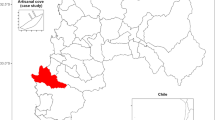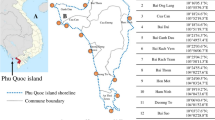Abstract
Saltwater fishing tournaments in the United States are generally not regulated nor are there different fishing regulations for tournament and nontournament anglers. Although much is known about those who participate in fishing tournaments in terms of their fishing motivations, attitudes, and characteristics, much less is known at the angler population level regarding their preferences for tournament opportunities. Using a stated preference choice model with hypothetical scenarios to simulate participation choices and understand preferences, study objectives were to identify angler preferences for various types of tournament fishing “products.” Four tournament policy characteristics were investigated: promotion of catch and release, bait restrictions, whether a percentage of the tournament entrance fee should go to support fishery management activities, and whether a tournament should be a nonprofit or profit-making venture. Three expectation attributes were inserted: tournament size, trip cost per day, and whether a tournament is family friendly. We sent seven different versions of the mail questionnaire to 1,633 anglers. Of 795 returns, 648 were used for estimating conditional logit models. Analysis indicated that a scenario with no management interventions was not most preferred. Anglers most preferred a conservation-oriented option that introduced additional management measures. Overall, scenarios with management interventions were more favored than the status quo situation (with no management interventions). Although respondents showed reluctance to adopt other management-related options, results generally indicated they were increasingly concerned with sustainability of fish stocks and potential conflicts between tournament and nontournament users and preferred tournament products that reflect these concerns.

Similar content being viewed by others
Literature Cited
Aas O, Haider W, Hunt L (2000) Angler responses to harvest regulations in Engerdal, Norway: a conjoint based choice modeling approach. North American Journal of Fisheries Management 20:940–950
Anderson DK, Ditton RB (2003) Demographics, participation, attitudes, and management preferences of Texas anglers, 2001 (TAMU-WFSC-HD-624). Texas A & M University, Department of Wildlife and Fisheries Sciences, College Station, TX
Antia U, McConney P, Ditton RB (2002) The socio-economic characteristics of tournament anglers in Barbados. Gulf and Caribbean Fisheries Institute 53:357–366
Babbie E (2001) The practice of social research, ninth edition. Wadsworth/Thomson Learning, Belmont, CA
Bates IJ, Carson RT, Day B, Hanemann M, Hanley N, Hett T, et al. (2002) Economic valuation with stated preference techniques: a manual. Edward Elgar, Northampton, MA
Ben-Akiva M, Lerman SR (1985) Discrete choice analysis: theory and application to travel demand. MIT Press, Cambridge, MA
Bennett J, Adamowicz V (2001) Some fundamentals of environmental choice modeling. In Bennett J, Blamey R (eds.) The choice modeling approach to environmental valuation. Edward Elgar, Northampton, MA. pp 37–69
Bennett JW, Blamey R (2001) The strengths and weaknesses of environmental choice modeling. In Bennett JW, Blamey R (eds.), The choice modeling approach to environmental valuation. Edward Elgar, Northampton, MA. pp 227–242
Boxall P, Adamocwicz WL (2002) Understanding heterogeneous preferences in random utility models: a latent class approach. Environmental and Resource Economics 23:421–446
Boxall PC, MacNab B (2000) Exploring the preferences of wildlife recreationists for features of boreal forest management: a choice experiment approach. Canadian Journal of Forest Research 30:1931–1941
Bryan H (1977) Leisure value systems and recreational specialization: the case of trout fishermen. Journal of Leisure Research 9:174–187
Christian RT, Trimm DL (1986) An inventory of Texas saltwater fishing tournaments: spatial, temporal and participation patterns in 1983 (Management Data Series No. 97). Texas Parks and Wildlife Department Coastal Fisheries Branch, Austin, TX
Dillman DA (1978) Mail and telephone surveys: the total design method. Wiley, New York, NY
Ditton RB, Anderson DK, Bohnsack BL, Sutton SG (1999a) Texas International Fishing Tournament: participants’ characteristics, participation in fishing, attitudes, expenditures, and economic impacts. (TAMU-WFSC-HD- 621). Texas A & M University, Human Dimensions of Fisheries, College Station, TX
Ditton RB, Anderson DK, Thigpen III JF, Bohnsack BL, Sutton SG (1999b) Pirate’s Cove Big Game Tournaments: participants’ characteristics, participation in fishing, attitudes, expenditures, and economic impacts. (TAMU-WFSC-HD-615). Texas A & M University, Human Dimensions of Fisheries, College Station, TX
Ditton RB, Loomis DK (1985) 1983 Texas International Fishing Tournament: an analysis of participants’ characteristics, attitudes and expenditures. (TAMU-SG-85-202). Texas A & M University Sea Grant Program, College Station, TX
Ditton RB, Loomis DK, Choi S (1992) Recreation specialization: re-conceptualization from social world’s perspective. Journal of Leisure Research 24:33–51
Driver BL (1985) Specifying what is produced by management of wildlife by public agencies. Leisure Sciences 7:281–295
Falk JM, Graefe AR, Ditton RB (1989) Patterns of participation and motivation among saltwater tournament anglers. Fisheries 14(4):10–16
Fedler AJ (1998) Applying human dimensions information to recreational fisheries management in the Gulf and Caribbean. Gulf and Caribbean Fisheries Institute 50:1075–1088
Gillis KS, Ditton RB (2002) A conjoint analysis of U.S. Atlantic billfish fishery management alternatives. North American Journal of Fisheries Management 22:1218–1228
Greene WH (2000) Econometric analysis. Prentice Hall, Upper Saddle River, N .J
Hanemann WM (1984) Welfare evaluations in contingent valuation experiments with discrete responses. American Journal of Agricultural Economics 66:332–341
Hanley N, Mourato S, Wright RE (2001) Choice modeling approaches: a superior alternative for environmental valuation? Journal of Economic Surveys 15(3):435–462
Hanley N, Wright R, Adamowicz V (1998) Using choice experiments to value the environment. Environmental and Resource Economics 11:413–428
Hanley N, Wright R, Alvarez-Farizo B (2006) Estimating the economic value of improvements in river ecology using choice experiments: an application to the water framework directive. Journal of Environmental Management 78(2):183–193
Hausman J, McFadden D (1984) Specification tests for the multinomial logit model. Econometrica 52:1219–1240
Hensher DA (1994) Stated preference analysis of travel choices: the state of practice. Transportation 21:107–133
Holmes TP, Adamowicz V (2003) Attribute-based methods. In Champ PA, Boyle KJ, Brown TC (eds.) A primer on nonmarket valuation. Kluwer Academic, Boston, MA. pp 171–220
Hunt LM, Haider W, Bottan B (2005). Accounting for varying setting preferences among moose hunters. Leisure Sciences 27:297–314
Jacob GR, Schreyer R (1981) Conflict in outdoor recreation: a theoretical perspective. Journal of Leisure Research 12:368–380
Kaoru Y (1995) Measuring marine recreation benefits of water quality improvements by the nested random utility model. Resource and Energy Economics 17:119–136
Loomis DK, Ditton RB (1987) Analysis of motive and participation differences between saltwater sport and tournament fishermen. North American Journal of Fisheries Management 7:482–487
Loomis DK, Ditton RB (1993) Distributive justice in fisheries management. Fisheries 18:14–18
Louviere JJ (1988a) Conjoint analysis modeling of stated preference: A review of theory, methods, recent developments and external validity. Journal of Transport Economics and Policy 22: 93–119
Louviere JJ (1988b) Analyzing individual decision-making: metric conjoint analysis. Sage University Series on Quantitative Applications in the Social Sciences No. 67. Sage, Newbury Park, CA
Louviere JJ (2000) Why stated preference discrete choice modeling is NOT conjoint analysis (and what SPDCM is?). Memetrics White Paper
Louviere JJ (2001) Choice experiments: An overview of concepts and issues. In Bennett JW, Blamey R (eds.) The choice modeling approach to environmental valuation. Edward Elgar, Northampton, MA. pp 13–36
Louviere JJ, Hensher D, Swait J (2000) Stated choice methods: analysis and application. Cambridge University Press, UK
Louviere JJ, Timmermans H (1990) Stated preference and choice models applied to recreation research: a review. Leisure Sciences 12:9–32
McFadden D (1974) Conditional logit analysis of qualitative choice behavior. In Zarembka P (eds.) Frontiers in econometrics. Academic, New York, NY. pp 105–142
Morrison M, Bennett JW, Blamey R (1999) Valuing improved wetland quality using choice modeling. Water Resources Research 35(9):2805–2814
Nielsen LA (1985) Philosophies for managing competitive fishing. Fisheries 10(3):5–7
Oh C, Ditton RB, Gentner B, Riechers R (2005) A stated discrete choice approach to understanding angler preferences and tradeoffs for management options. Human Dimensions of Wildlife 10(3):173–186
Oh C, Ditton RB (2006) Using recreation specialization to understand multi-attribute management preferences. Leisure Sciences 28:369–384
Schmied RL (1994) A history and overview of fishing tournaments (Special Report No. 46). In Proceedings of the Workshop on Saltwater Tournaments. Atlantic States Marine Fisheries Commission, Washington, DC. pp 1–8
Thailing CE, Ditton RB, Anderson DK, Murray TJ, Kirkley JE, and J. Lucy (2001) The 2000 Virginia Beach Red, White, and Blue Fishing Tournament: participants’ characteristics, attitudes, expenditures, and economic impacts (Virginia Marine Resource Report No. 2001-9, VSG-01-88). College of William and Mary, Virginia Institute of Marine Science. Gloucester Point, VA
Train KE (1998) Recreation demand models with taste differences over people. Land Economics 74:230–239
Williams T (1984) Fishing to win. Audubon 86(3):82–95
Acknowledgments
Funding support for this research, which came from the TPWD Coastal Fisheries Division and the Texas Agricultural Experiment Station, was much appreciated.
Author information
Authors and Affiliations
Corresponding author
Rights and permissions
About this article
Cite this article
Oh, CO., Ditton, R.B. & Riechers, R. Understanding Anglers’ Preferences for Fishing Tournament Characteristics and Policies. Environmental Management 40, 123–133 (2007). https://doi.org/10.1007/s00267-006-0010-7
Received:
Accepted:
Published:
Issue Date:
DOI: https://doi.org/10.1007/s00267-006-0010-7




